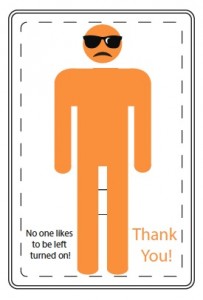
The University of Rochester has been making continual strides towards sustainability for several years now. So, earlier this academic year when Rochester Institute of Technology (RIT) approached the University of Rochester on participating in an energy study, the University eagerly accepted the opportunity. Through this study, select dormitories were chosen on both campuses to receive materials targeted at reducing energy use, unplugging electronics, and turning off lights. Energy usage was then monitored to see if there was any change in the dormitories who received the material.
At the University of Rochester, the site of the study was Anderson Tower of Jackson Court. Wilder Tower served as the control. These buildings were deemed as good for comparison due to their similarities in size, layout, student population, and Energy Star rating. In late October 2012, Anderson residents were given various materials (two examples shown in the attached images). Over at RIT, four buildings in the Global Village dormitories were given the same visuals. Energy meter readings were taken from the buildings through December and then examined.
The study was primarily conducted by Assistant Professor of Communication, Dr. Kelly Martin and her graduate students. The graduate students come from multiple areas of RIT – a Program in Communication, Media, and Technology, Imaging Arts and Sciences, and the Business School. This background meant a variety of disciplines working together to create the strongest visuals possible.

At the University of Rochester, the study was coordinated through Recycling Coordinator Amy Kadrie, Residential Life Area Coordinator Bert Bones, and data provided by Levi Olsen, Manager of Building Controls.
Due to time and grant restraints, the study remained small in scope. In Anderson, the energy consumption results did not decrease in November as anticipated. However, there were other factors involved that may have played a role in the results including the short time period and the colder temperatures outside. The results at RIT did show less kilowatt energy used in the buildings with the visuals. However, before any real conclusions can be drawn, a more extensive study should be conducted. Dr. Martin and her team hope that the results of this study will provide the impetus to receive a larger grant in order to fund the study for longer, at more dormitories, and maybe even at other universities. A larger study would likely use many of the same visual materials and would be conducted over a longer time period, perhaps over a few years as opposed to a few months.
The study of behavioral change via visual persuasion is the primary focus. As said by Dr. Martin, “In summary, I think the data at RIT was promising and maybe we learned that the visuals might need to be tailored to the university and the type of student. I think for the time period we had to work with and the resources we had, the results were about what we could expect. At least it continues to get students thinking about energy usage. I know my graduate students who worked on the project said that they definitely have changed their energy usage habits.” In fact, student response has been primarily positive at RIT, and it is likely student reaction will remain positive as the study grows.
For more information about the energy study, contact Dr. Kelly Martin at knmgpt@rit.edu.
By Alanna Scheinerman, Class of 2013

Good job, I hope you can help the RIT to decrease its energy consumption by increasing the awareness of the energy efficiency. Fossil fuels are not limitless, world need to revolt in change of renewable sources. However we need to care much about how we use the energy.